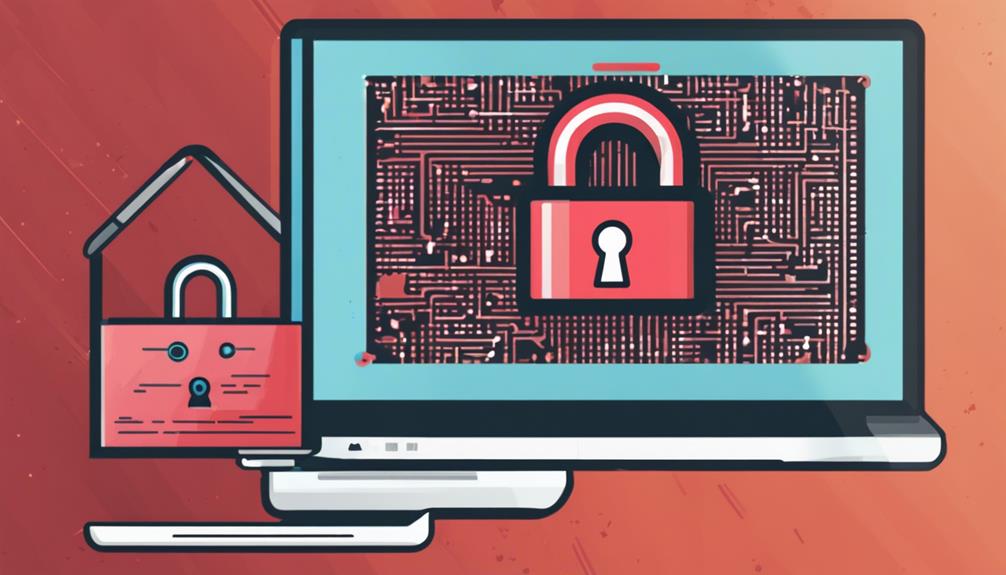Encountering Ora-12269 error? Your data security may be compromised with weak encryption. Outdated methods open doors for breaches and unauthorized access. Take action to safeguard your information.
Key Takeaways
- Ora-12269 indicates mismatched encryption versions.
- Risk of unauthorized access and data tampering.
- Outdated encryption methods pose security vulnerabilities.
- Weak checksumming compromises data integrity.
- Upgrading to industry-standard encryption is crucial.
Understanding the Ora-12269 Error

To understand the Ora-12269 error, you need to grasp its implications on your system's encryption and checksumming capabilities. This error signifies that the client is using a version of encryption or crypto-checksumming that's considered weak or outdated for secure database connections.
When this error occurs, it can pose a significant security risk to your system, leaving it vulnerable to potential breaches or unauthorized access.
The Ora-12269 error often arises when there's a mismatch between the client and server's encryption algorithms or checksumming methods. This mismatch can lead to a failure in establishing a secure connection between the client application and the Oracle database.
As a result, sensitive data transmitted between the client and server may be at risk of interception or tampering.
To address the Ora-12269 error, you must make sure that both the client and server are using compatible and secure encryption and checksumming protocols. Upgrading to stronger encryption algorithms and checksumming methods will help enhance the security of your system and prevent future occurrences of this error.
Implications of Weak Encryption
Critical encryption can jeopardize the confidentiality and integrity of your sensitive data. When your data is protected by weak encryption methods, malicious actors can easily intercept and decipher your information. This puts your personal information, financial data, and any other sensitive data at risk of being stolen or manipulated without your knowledge.
Furthermore, weak encryption can lead to breaches in compliance regulations and industry standards. If your organization handles sensitive data, using inadequate encryption measures can result in severe consequences such as legal penalties, loss of reputation, and financial damages. It's essential to verify that your encryption protocols meet the current security standards to protect your data effectively.
In addition, weak encryption can also impact the performance of your systems. Inefficient encryption algorithms can slow down data processing and transmission, leading to delays and decreased productivity. By employing strong encryption methods, you can safeguard your data against unauthorized access and maintain the confidentiality and integrity of your information.
Identifying Outdated Encryption Methods

Identifying outdated encryption methods is essential for maintaining the security of your data and systems. Using weak encryption algorithms or outdated cryptographic protocols can leave your information vulnerable to cyber threats. To help you recognize and address these issues, here are some common outdated encryption methods that you should be aware of:
| Outdated Encryption Methods | Description | Risks |
|---|---|---|
| DES (Data Encryption Standard) | Symmetric key algorithm vulnerable to brute-force attacks | Data exposure and compromise |
| MD5 (Message Digest Algorithm 5) | Hash function susceptible to collisions and hash extension attacks | Data integrity risks |
| SSL v3 (Secure Sockets Layer version 3) | Outdated protocol with known vulnerabilities like POODLE attack | Man-in-the-middle attacks |
Risks of Crypto-Checksumming Vulnerabilities
Essential encryption methods like weak encryption algorithms and vulnerable cryptographic protocols can expose your data to risks, including vulnerabilities related to crypto-checksumming. When cryptographic checksums are weak or poorly implemented, they can be exploited by attackers to tamper with data integrity, leading to potential security breaches.
One of the main risks of crypto-checksumming vulnerabilities is the possibility of data being altered during transmission without detection. This could result in unauthorized modifications to sensitive information or the insertion of malicious content, compromising the confidentiality and reliability of your data.
Furthermore, weaknesses in crypto-checksumming can also impact the overall security of your system by providing avenues for attackers to launch various cyber attacks, such as man-in-the-middle attacks or data manipulation. It's important to address these vulnerabilities promptly by updating encryption methods and cryptographic protocols to more secure standards, ensuring the integrity and confidentiality of your data.
Impact on Data Security

How does the use of weak encryption/crypto-checksumming versions impact the security of your data?
Weak encryption and crypto-checksumming versions can greatly compromise the security of your data. When encryption algorithms or checksumming methods are weak, they become more susceptible to attacks by hackers and malicious actors. These vulnerabilities can lead to unauthorized access to your sensitive information, putting your data at risk of theft or manipulation.
Furthermore, weak encryption/crypto-checksumming can result in data breaches, where confidential data is exposed to unauthorized parties. This can have severe consequences, including financial loss, reputational damage, and legal implications. Inadequate encryption can also make it easier for attackers to intercept and tamper with your data as it's transmitted over networks, endangering the integrity and confidentiality of your information.
To safeguard your data effectively, it's important to use robust encryption and crypto-checksumming methods that adhere to industry standards and best practices. Upgrading to stronger encryption protocols can help fortify your data security and protect your information from potential threats.
Strategies for Encryption Enhancement
Improving encryption methods is essential for bolstering the security of your data against potential threats. To enhance encryption, consider implementing advanced encryption algorithms like AES (Advanced Encryption Standard) with longer key lengths, which can provide stronger protection against cyber threats.
Additionally, incorporating multi-factor authentication alongside encryption can add an extra layer of security by requiring multiple credentials for access.
Regularly updating encryption protocols and staying informed about the latest encryption technologies is vital to maintaining a secure environment for your data. Conducting regular security audits to identify vulnerabilities in your encryption processes and promptly addressing any weaknesses can help prevent potential security breaches.
Furthermore, implementing end-to-end encryption for data transmission can safeguard sensitive information from being intercepted during communication. Utilizing encryption key management systems can help securely store and manage encryption keys, ensuring only authorized users can access encrypted data.
Updating Client Encryption Settings

Consider adjusting the encryption settings on your client to guarantee robust data protection against potential security threats. By updating your client's encryption configurations, you can enhance the security of your data transmissions and safeguard sensitive information from cyber threats. Below is a comparison table to help you understand the differences between weak and strong encryption settings:
| Encryption Type | Weak Encryption Settings | Strong Encryption Settings |
|---|---|---|
| Algorithm | DES | AES |
| Key Length | 56 bits | 256 bits |
| Vulnerabilities | Prone to brute force attacks | Resistant to brute force attacks |
| Recommended Usage | Legacy systems | Modern security standards |
Troubleshooting Connection Issues
To resolve connection issues efficiently, diagnose potential network problems systematically. Start by checking if the client and server are using compatible encryption/cryptography versions. Confirm both sides are configured to use the same encryption algorithms and protocols to establish a secure connection.
Next, verify that the network firewall settings allow communication between the client and server on the required ports. Make sure there are no restrictions blocking the connection. Additionally, validate that the client has the necessary permissions to access the database server. Incorrect permissions can lead to connection failures.
If the issue persists, consider restarting both the client and server systems to refresh their network configurations. It's also advisable to double-check the connection string parameters for accuracy.
Enhancing Database Security Measures

Enhance your database security measures by implementing multi-factor authentication for user access. By requiring users to verify their identity through multiple methods such as passwords, security tokens, or biometric data, you add an extra layer of protection against unauthorized access.
To further strengthen your database security, consider the following measures:
| Security Measure | Description |
|---|---|
| Regular Audits | Conduct routine audits to identify any vulnerabilities or unusual activities. |
| Encryption Implementation | Encrypt sensitive data at rest and in transit to prevent unauthorized access. |
| Access Control Policies | Define clear access control policies to restrict user permissions based on roles. |
| Security Patch Updates | Keep your database system up to date with the latest security patches to address known vulnerabilities. |
| Employee Training | Provide regular training to employees on best security practices to prevent breaches. |
Ensuring Compliance With Encryption Standards
Implementing encryption standards is essential for ensuring compliance with data security regulations and safeguarding sensitive information. By adhering to established encryption protocols, you can mitigate the risk of unauthorized access to confidential data. Encryption standards such as AES (Advanced Encryption Standard) and RSA (Rivest-Shamir-Adleman) provide robust mechanisms to protect data both at rest and in transit.
To guarantee compliance with encryption standards, it's imperative to regularly update encryption algorithms and keys to stay ahead of potential vulnerabilities. Conducting regular security audits and assessments can help identify any weaknesses in your encryption implementation and address them promptly.
Furthermore, educating your team on the importance of encryption and data security practices is essential for maintaining compliance with industry regulations. By fostering a culture of security awareness, you can empower your employees to uphold encryption standards in their day-to-day activities.
Conclusion
To address the ora-12269 error, update your client encryption settings to utilize stronger encryption methods and ensure adherence to encryption standards. This will help improve database security and mitigate the risks associated with weak encryption and crypto-checksumming vulnerabilities.
By following these steps, you can safeguard your data and maintain a secure connection to your database.
